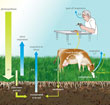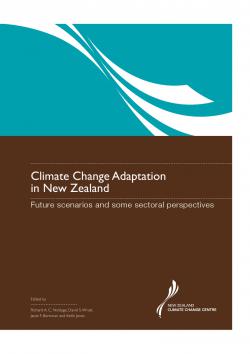I‘m going to be away from my desk for a few days this week, so here’s a few interesting things to read and reflect on. First up: Wellington’s hosting this year’s New Zealand Soil Carbon Conference at Te Papa from Wednesday to Friday. Keynote speakers are Tim Flannery and Christine Jones, and topics to be covered include:
- The science behind climate change and soil carbon
- The on-farm benefits of biological farming
- How research can support innovative farmers
- An overview of the new biological economy and market opportunities
- Practical tips to build soil carbon, humus and soil biology
- Future directions for NZ agriculture and extension services
Full programme here — Friday’s a field trip day. Sounds very worthwhile. If any HT readers are attending (or if the conference organisers are reading this), I’d be very happy to carry a report on events.
Adding to the long list of material debunking standard sceptic & crank claims about climate change, Deutsche Bank’s Climate Change Advisors (DBCCA) have produced a nicely referenced document (PDF), prepared for them by the Earth Centre at Columbia University. Here’s a sample from the executive summary:
Claim: Human society and natural systems have adapted to past climate change.
Response: Past climate changes have often been accompanied by migration, war, and disease. The growing human population will inevitably make environmental change more disruptive in the future, even in the face of increased technological prowess.
A couple of items from Nature News: in Collapse of the ice titans, NN interviews Richard Bates, recently returned from a summer sail along Greenland’s NW coast on the Gambo (more on that voyage at Jason Box’s Meltfactor.org blog) about the melt season at the Petermann and Humboldt glaciers. Ocean conveyor-belt model stirred up looks at a new paper in Nature Geoscience that finds greater than expected variability in the great ocean current network known as the Thermohaline Circulation (THC). Understanding the short term changes in THC flows will be important in attempts to model short term and regional climate change.
The Arctic sea ice looks to be fast approaching its summer minimum, heading for somewhere between 2008 and 2009 — making it the third lowest in the record. Best place to keep up with events is (as it has been all NH summer) Neven’s Arctic Sea Ice blog. The two boats (Northern Passage, Peter 1) attempting to circumnavigate the Arctic Ocean in a single season are both now heading for the southern route of the NW Passage. In the southern Beaufort Sea the Norwegian team are reporting high sea temperatures:
We are still surprised and worried about the high water temperature. At the moment we are registering around 7 to 8 degrees Celsius, which according to the experts is far higher than normal.
Also of interest for sea ice aficionados: a new paper in Quaternary Science Reviews looks at what we know of the history of Arctic sea ice. Coverage at Climate Central and Science Daily but here’s Climate Central talking to the NSIDC’s Mark Serreze:
“They’re telling us that there was maybe no ice during the Arctic summers 7,000 years ago, and also ice-free summers during the last interglacial 125,000 years ago.” Those were due to natural factors, most notably the changes in Earth’s orientation to the Sun that brought more sunlight to the Arctic in summer. This time, says the paper, there is no known natural explanation, and climate skeptics who claim the ice is rebounding after the 2007 low, he says, “are grasping at straws.”
And finally: the British government starts planning to adapt to inevitable warming (but offers no new money). Plus ça change…


 How will our land-based primary industries manage the climate changes ahead? That’s the question addressed by chapter 3 in Climate Change Adaptation in New Zealand (pdf download
How will our land-based primary industries manage the climate changes ahead? That’s the question addressed by chapter 3 in Climate Change Adaptation in New Zealand (pdf download  I opened the farming page of the Waikato Times yesterday evening to see a prediction from Lincoln University agribusiness professor
I opened the farming page of the Waikato Times yesterday evening to see a prediction from Lincoln University agribusiness professor  Tomorrow morning, a large chunk of New Zealand’s much debated Emissions Trading Scheme comes into effect. Forestry’s already been in it for two years, but July 1st is the day that the liquid fuels and electricity generation sectors start to have to account for their emissions, and it’s the first day that consumers might see a change in fuel and electricity prices that can be blamed on the ETS. Last week’s National Business Review had a pretty good overview of the state of play
Tomorrow morning, a large chunk of New Zealand’s much debated Emissions Trading Scheme comes into effect. Forestry’s already been in it for two years, but July 1st is the day that the liquid fuels and electricity generation sectors start to have to account for their emissions, and it’s the first day that consumers might see a change in fuel and electricity prices that can be blamed on the ETS. Last week’s National Business Review had a pretty good overview of the state of play